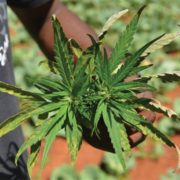Fil-Ams react to new rules
AS of Monday, January 1, Californians were officially allowed to participate in the recreational use of marijuana without the need of a medical marijuana card.
Proposition 64 — which was passed back in November 2016 by a 15-percent margin — has come into effect, making California the sixth and largest state in the U.S. to legalize recreational marijuana use, following Colorado, Washington, Oregon, Washington D.C, and Alaska.
The full implementation comes 20 years after California became the first to legalize medical marijuana in 1996.
For many Californians, the rollout meant enduring long lines outside dispensaries Monday in celebration.
Cristina Espiritu, 40, of Anaheim told the Asian Journal that the legalization also means an opportunity for open dialogue which is one of her business’ goals. She’s the founder of the 420 Foodie Club, an online community and resource for those who like to cook with cannabis — think a marijuana-infused Tastemade or Food Network.
Being Filipina, food played a big part in her life, and including cannabis was just another way she said brought people together. She hopes her business changes the perception of marijuana which she attributed to unregulated cannabis, or “dirty weed,” through cannabis-laced cuisines that are not “pot brownies.”
“Now, you see a lot of craft products and organic products,” said Espiritu whose site includes recipes for cannabis-infused poutine, pesto, banana bread, and even a number of Filipino dishes.
Multi-billion dollar industry
The outlook of the expanding California cannabis industry may indicate similar views by those in the business. According to cannabis industry-tracking firm BDS Analytics, sales are expected to hit $3.7 billion in 2018, and possibly $5.1 billion in 2019 as dispensaries go online.
Business World compared the numbers to California’s beer sales which hit $5 billion last year, according to IBIS World.
Approximately $40 billion and over 400,000 jobs in the U.S. is further projected by 2021, reported consulting firm Arcview.
But the numbers don’t come without concerns, according to Espiritu, who has a joint JD/MBA from Penn State University.
“They bring both positive and negative things to the table, depending on what part of the issue you’re at,” she said about the new California regulations.
Main concerns for those on the business end are financial as the new regulations also mean new sets of licenses and taxes.
For one thing, there’s finding a proper kitchen that allows cannabis cooking — Espiritu shared that un-infused and infused food can’t be together. Manufacturers are also prohibited from manufacturing cannabis products that include perishable items for retail sale.
For organizers who often hold cannabis-centered food events, a license priced at $5,000 a year to host up to 10 events is required, according to an article in the LA Times. Cities may also ask for additional fees or even ban an event, the article added.
“I understand that they’re there to instill health and safety to the consumers, but for small businesses, it’s cost prohibitive,” said Espiritu, forecasting that many of the smaller businesses in the next couple years will find themselves having to either rethink their business models to survive or die.
As for moving past the stigma, the issue may not be so big a deal for some in the Fil-Am community — at least according to Espiritu and 23-year-old Fil-Am James Macatangay.
This comes despite the fact that the issue of drug use has taken center stage in the Philippines since the election of country’s president Rodrigo Duterte.
Macatangay, who was born in Nevada but moved to California where he now works as a microbiology lab technician in the cannabis industry, said that those around him have generally not been against it.
“It’s often [an] ‘I don’t care what you do as long as it doesn’t hurt me’ attitude,” Macatangay told this writer on Quora, a question-and-answer site. “I’ve only met a handful who actually fell for the Reefer Madness.”
Espiritu, who grew up in the Philippines before moving to the U.S. at the age of 15, shared similar comments.
“I get a mixed bag, but what’s surprising to me is I see a lot more acceptance as the dialogue becomes more known,” said Espiritu. “People fear what they don’t know most of the time, so I think a lot of people, especially the older generation — if you give them information or testimonials, a lot of them are actually willing to try it.”
Since coming into office, Duterte’s notorious war on drugs has been campaigned as waging against drug users, with crystal meth, or “shabu” as it is nationally called, being a common choice of drug.
But when it comes to marijuana use — medicinal, that is — Duterte has to many people’s surprise showed support, calling it “effective” during his 2016 campaign.
“I will not deprive Filipinos of the benefits of medicinal marijuana, but I must have a clear definition of what is and it must be approved by the FDA [the Philippines’ Food and Drug Association],” said Duterte who continues to crack down on recreational use.
Future of medical marijuana in the PH
Just last year, the Philippines House of Representatives committee unanimously approved the Philippine Compassionate Medical Cannabis Act (House Bill 180) which was created to allow marijuana use for medicinal purposes.
If passed, the Philippines could be the first country in Southeast Asian to legalize medical marijuana.
But there’s still a chance it won’t happen, as big names like Philippine Senate Majority Leader Vicente Sotto III, and institutions like the University of the Philippines-Manila strongly oppose its legalization.
The main arguments by those opposed to marijuana use remain its effects on health including addiction, memory loss, reducing learning functions, cancer, and cardiovascular and lung problems.
Sites like WebMD and MayoClinic.org continue to report on the effects of marijuana on health, but generally, say that more study is needed to make definite conclusions.
“I don’t think we can definitively say it is safe,” Jeanette Marie Tetrault, MD, FACP of Yale University School of Medicine said in a WebMD article.
Espiritu though, joins those who advocate its medicinal use. She shared that many of the people she’s been working with are Filipino caretakers whose patients take cannabis for pain medication. Tinctures allow cannabis to be sprinkled onto salad dressing or in lemonade, she shared.
As California welcomes the full implementation, here’s what is worth knowing.
Legal vs. illegal
Under Proposition 64, also known as the Adult Use of Marijuana Act, adults 21 years old or older can now legally consume or purchase up to an ounce of marijuana bud, or eight grams of concentrated cannabis from any licensed dispensary without a medical marijuana card.
Californians may also legally grow up to six marijuana plants in their home, but plants must be in a locked area and out of sight from a public place. Businesses, employers, and property owners may prohibit marijuana use or possession on their premises.
Smoking marijuana is still illegal in public spaces and generally anywhere tobacco smoking is prohibited. Those caught can be slapped with a fine of up to $100, a change from being charged with possession.
Prohibited areas include anywhere within 1,000 feet of a school, day-care, youth center, or any other area where children are present — the fine increases up to $250 if caught in such areas.
And as the lighted signs on freeways reading “Drive high, get a DUI“ suggest, driving under the influence of marijuana is also illegal and dangerous. This includes driving boats and aircrafts.
Not exactly legal everywhere in CA
It is important to note that consuming marijuana is also still federally illegal. That means aside from having to keep it in California, marijuana also cannot be brought onto federal lands which include national parks, national wild refuges, federal prisons, military reservations, and any other areas owned by the federal government.
Local governments within California can also implement bans on marijuana activity, which Kern County did, for example.
Furthermore, employers are still allowed to enforce drug-free workplaces and conduct drug tests.
Taxes and cash-only purchases
Now that marijuana is legal in California, marijuana consumers can expect a state excise tax of 15 percent on retail marijuana sales, and state cultivation taxes on marijuana of $9.25 per ounce of flowers and $2.75 per ounce of leaves.
Those with medical marijuana cards are exempt from some taxation.
Purchasing marijuana will also be cash only. Again, as selling marijuana is still federally illegal, related transactions will not be dealt with by banks.
Criminal reclassification
According to a survey published last fall by drug law reform advocate group Drug Policy Alliance, over 2,100 people in California have been incarcerated for marijuana-only offenses in 2015.
In the last decade, the group reported that nearly half a million marijuana arrests were made in California in the last decade.
With the law change, those serving time for marijuana-related offenses may petition a judge to possibly resentence their case or get their sentence reduced, or even get out of jail. Records may also be reclassified or wiped clean.






